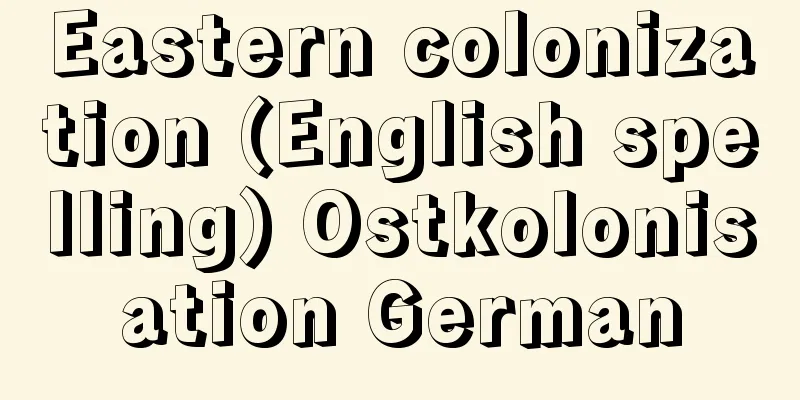Eastern colonization (English spelling) Ostkolonisation German

|
The colonization of the Slavic regions of the East by Germans took place from the early 12th century to the 14th century. It is also called the East German colonization movement. It can be divided into an early period (until the early 13th century) when colonization was promoted mainly by the feudal lords of the eastern border region, and a later period when the Prussian conquest and colonization were carried out mainly by the Teutonic Knights. After the migration, the eastern border of the Germanic peoples' settlement area was roughly the line connecting the Elbe River and its tributary, the Saale River, the Bohemian Forest, and the eastern border of Bavaria, and the area east of this was inhabited by Slavs. From the 10th century onwards, Christian churches in this area were active, many bishoprics were built, and the foundations for the later eastern colonization were laid, but apart from the southern area adjacent to Bavaria, colonization did not progress very much, and in particular, as a result of the great Slavic revolt of 983, the marks east of Saxony that had been established between the Elbe and Oder Rivers had to be abandoned. However, from the beginning of the 12th century, active colonization was resumed, and a full-scale eastern colonization movement began. This was a time of economic growth in Germany itself, as seen in the development of cities and the flourishing of domestic reclamation. The resulting rapid population increase led to a surplus population that flowed out in the form of eastern colonization. The great princes of the eastern border region, such as Henry the Lion of Saxony, Margrave Albrecht of the Northmark (later Mark-Brandenburg), and Margrave Conrad of Meissen and Lusatia, made a great contribution by actively inviting colonists, establishing colonial villages, and building cities in key locations in order to expand their territories eastward and form their own territories. After 1147, these princes jointly waged a war of conquest (the Wendish Crusade) against the Slavs (who Germans call Wends) in the region between the Elbe and Oder rivers. As a result, the biggest obstacle, organized resistance by the indigenous people, was removed, and the colonization movement proceeded with tsunami-like momentum. From the first half of the 13th century onwards, the Teutonic Knights joined in as the main players in the colonisation movement. In 1226, Conrad, a Polish feudal lord who had trouble with the resistance of the Prussians, entrusted the Knights with the task of Christianising them. By 1283, the Knights had conquered the whole of Prussia, and although it was nominally under the suzerainty of the Polish king, it had in fact created the Territory of the Teutonic Knights, which could be considered almost an independent state. The feudal lords and knights entrusted the actual execution of the colonization project to contractors called locators. The locators recruited colonists in Germany and led them in building the colonial villages. As village heads, the locators were granted privileges such as judicial power, and collected rent from the villagers and paid it to the feudal lords and knights. Among the cities built in the colonies, some were mother cities, such as Hanseatic cities or other cities in the home country, and merchant groups from the mother cities built daughter cities called Tochterstaads, such as seaport cities along the Baltic Sea coast and relatively large commercial cities, but many medium-sized and small inland cities were built under contract to locators in a similar manner to the colonial villages. After World War II, there was a conflict of views regarding the historical evaluation of the East German colonization between historians in the former West Germany, who emphasized its contribution to the improvement of the economy and culture of the region, and historians in the former East Germany and the socialist bloc, who viewed it negatively as nothing more than aggressive colonization. This is related to the fact that in West Germany at that time, the term "Eastern migration" (Ostsiedlung or Ostbewegung) came to be used instead of East German colonization. [Shosuke Hirajo] Source: Shogakukan Encyclopedia Nipponica About Encyclopedia Nipponica Information | Legend |
|
12世紀初頭より14世紀まで行われたドイツ人の東方スラブ人居住地域への植民事業。東ドイツ植民運動ともいう。主として東部国境地域の領邦君主によって植民が推進された前期(13世紀初頭まで)と、ドイツ騎士団が中心となってプロイセンの征服、植民が行われた後期とに分けられる。 民族移動後のゲルマン人の定住地域の東境は、ほぼエルベ川とその支流ザーレ川、ボヘミアの森とバイエルン東境を連ねる線であり、それ以東はスラブ人の居住地であった。10世紀以降、この地域のキリスト教会が精力的に活動を行い、多数の司教座が建設され、後の東方植民の前提がつくられたが、バイエルンに隣接する南部地域を除けば、植民活動はあまり進展せず、とくに983年のスラブ人の大反乱の結果、エルベ、オーデル両川間に設置された、ザクセン東方の諸マルクも放棄せざるをえなかった。ところが12世紀初頭以来、活発な植民活動が再開され、本格的な東方植民運動が展開される。 この時代は、ドイツ本国でも都市の発展、国内開墾の盛行などから知られるように、一種の経済成長がみられた時期であり、それに伴う急激な人口増加によって生み出された過剰人口が、東方植民の形で流出した。ザクセンのハインリヒ獅子(しし)公、ノルトマルク(後のマルク・ブランデンブルク)の辺境伯アルプレヒト、マイセンとラウジッツの辺境伯コンラートなど東部国境地域の大諸侯たちが、東方に支配領域を広げて、それぞれの領国を形成すべく、積極的に植民を誘致し、植民村落の設置と、要地に都市建設を行った功績は大きい。1147年以降、これら諸侯が共同で、エルベ川とオーデル川に挟まれた地域のスラブ人(ドイツ人はこれをウェンド人Wendenとよぶ)に対する征服戦争(対ウェンド十字軍)を敢行した結果、先住民の組織的抵抗という最大の障害が除かれ、以後植民運動は津波のような勢いで進行した。 13世紀の前半以降は、植民運動の主役としてドイツ騎士団が加わる。1226年、プロイセン人の抵抗に手を焼いたポーランドの大領主コンラートが、彼らのキリスト教化を騎士団に委任したのがきっかけで、1283年までに、騎士団はプロイセン全域を征服し、ポーランド王の名目的宗主権の下にたつが、事実上はほとんど独立国家といえるドイツ騎士団領をつくりあげた。 領邦諸侯や騎士団は、実際の植民事業の遂行をロカトールLocatorとよばれる請負人にゆだねた。ロカトールは、ドイツ本国において植民者を募集し、彼らを率いて植民村落の建設を行った。ロカトールは村長として裁判権などの特権を賦与され、村民から地代を徴収して、領主である諸侯や騎士団に納めた。植民地域の建設都市のうち、バルト海沿岸の海港都市や比較的大きな商業都市のように、ハンザ都市その他本国の都市が母都市となり、母都市の商人団が娘都市Tochterstaadを建設したものもあるが、内陸の中・小都市の多くは、植民村落の場合と類似の方法で、ロカトールの請負により建設された。 第二次世界大戦後、東方植民の歴史的評価をめぐり、この地域の経済や文化の向上に寄与した点を強調する旧西ドイツの歴史家と、侵略的植民地化にすぎないと否定的に評価する旧東ドイツや社会主義圏の歴史家との間で、見解が対立している。当時の西ドイツで、東方植民のかわりに、「東方移住」(OstsiedlungないしOstbewegung)という表現が用いられるようになったのは、これと関係している。 [平城照介] 出典 小学館 日本大百科全書(ニッポニカ)日本大百科全書(ニッポニカ)について 情報 | 凡例 |
Recommend
Onikombu - Onikombu
...The giant kelp, which grows on the Pacific coa...
Nut sesame - Kinomi sesame
...On the other hand, as an adult hobby, many tra...
Toboku
A Chinese poet of the late Tang dynasty. He also ...
Wang Pu
...It is said that the beginning of the Tang Dyna...
Kalki (English spelling)
One of the incarnations of the god Vishnu in Hindu...
Kyoto
...Grape and peach cultivation began in earnest i...
Hino River
A river that flows through western Fukui Prefectur...
Lykourgos
[Born] Around 390 B.C. [Died] c. 324 BC Ancient Gr...
Willughby, F.
…Influenced by his mother who knew about herbs, R...
Chlam basistella (English spelling) Chlambasistella
… [Minoru Imajima]. … *Some of the terminology ex...
River Paradise Flycatcher - River Paradise Flycatcher
…There are about 10 species in the genus Parasito...
Kara
Italian painter. Born in Alexandria, Egypt. In 191...
staroobryadtsy
… 【religion】 [The role of the church] The Russian...
U‐rok (English spelling)
A 6th-century Korean musician from Gaya. Dates of ...
Ring King
…Afterwards, the country developed a transit trad...









